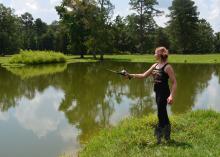Information Possibly Outdated
The information presented on this page was originally released on March 4, 2016. It may not be outdated, but please search our site for more current information. If you plan to quote or reference this information in a publication, please check with the Extension specialist or author before proceeding.
Determine goals for fishing holes
STARKVILLE, Miss. -- One of the most common questions I get is, “How do I manage the fish in my lake or pond?”
My responses to these landowners vary, but I usually ask them some questions of my own. What is your goal? Do you want big bass, big bream or just an overall increase in all fish species in your pond or lake? Once the lake owners set their goals, then we can go to work.
Mississippi has a population of fish that usually includes largemouth bass, bluegill (bream) and redear sunfish (shell crackers). We can grow only a limited number of pounds of fish per acre, so if our goal is to increase the average size of all species, we need to reduce the number of fish per acre. Normally, the larger the individual fish, the fewer fish you can have per acre of water.
New pond or lake owners often say, “It cost money to build and stock this lake, so I am not going to let anyone fish!” This attitude is a major mistake. We put the fish in there to enjoy, and we do that by fishing. The fish population needs to be harvested and enjoyed, but you do need to control what type of fish are removed.
If the goal is to grow bigger fish, you should harvest fish at a ratio of 1 pound of bass to 5 pounds of bream, usually beginning in the third year after stocking. For most ponds, 15 pounds of bass and 60-75 pounds of bream per acre can be harvested annually to keep the pond “balanced.”
If the pond is fertilized, double the rate of bass fishing and enjoy all of the bream you can catch. Few people ever catch too many bream from their ponds. Reducing the total population should increase the average size of the remaining fish of both species.
If your goal is to grow giant bass, remove the small bass, say 14 inches or less. More bream will survive and grow to feed larger bass, increasing the growth rates of the bass left in the pond.
If you want trophy bluegill, leave lots of small bass to feed on the bream spawn. This strategy will reduce the numbers of bream that survive and increase the food available to the remaining bream. The few surviving bream will grow fast, and they can reach sizes of a pound or larger.
In summary, the first step is to know what you want from your pond. Once your objective is set, you can work with a private consultant as you go through the management process, or you can take advantage of the many resources offered by the Mississippi State University Extension Service and do it yourself.
Whether you challenge yourself or pay a professional, success or failure depends on having an objective and a plan based on sound science to create the pond of your dreams!

Editor’s Note: Extension Outdoors is a column authored by several different experts in the Mississippi State University Extension Service.





